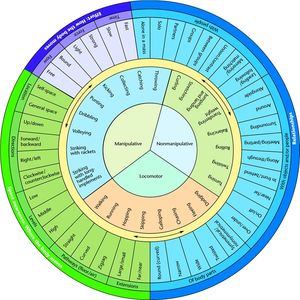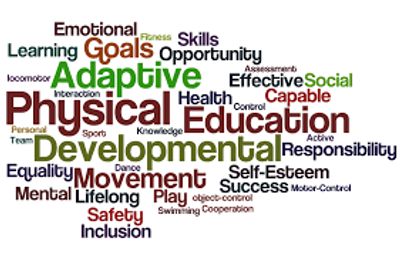What is Physical Education?

There is a grave difference between Physical Education, Physical Activity, & Athletics.
The intent of Physical Education is to help students learn the skills necessary for performing a variety of physical activities and understand the benefits of achieving and maintaining a physically active Lifestyle.
Physical Education is defined as:
A planned, sequential program of curricula and instruction that helps students develop the knowledge, attitudes, motor skills, self-management skills, and confidence needed to adopt and maintain a physically active and healthy Lifestyle.
Physical Education programs are the ONE place that:
- ALL children can participate in regular physical activity
- ALL children can become physically educated for a Lifetime of physical activity
PHYSICAL EDUCATION SHOULD BE TREATED WITH THE SAME LEVEL OF PROFESSIONAL CONCERN AS OTHER ESSENTIAL ACADEMIC DISCIPLINES AND LEARNING ENVIRONMENTS..
A Quality Physical Education program includes:
Curriculum
Curriculum that aligns with state learning standards and outcomes for Health & Physical Education
Actual PE Teacher

Curriculum is taught by a certified Health and Physical Education teacher
Ample OTRs & Equipment
Instruction & Assessment
Instruction & Assessment

Appropriate time and space for students to learn and practice skills with appropriate supplies
Instruction & Assessment
Instruction & Assessment
Instruction & Assessment

Instruction and assessment in the cognitive, affective, and psychomotor domains
What is NOT Physical Education?
ATHLETICS
PHYSICAL ACTIVITY
PHYSICAL ACTIVITY
Athletics is defined as an active sport that requires physical exertion and competition and involves a contest between athletes. While athletics typically focuses on one sport, Physical Education will teach knowledge of skills and concepts necessary for safe and healthy Living and in turn, for successful learning. Athletics are optional and does not promote participation by ALL students.
PHYSICAL ACTIVITY
PHYSICAL ACTIVITY
PHYSICAL ACTIVITY
Physical activity is defined by the Center of Disease Control and Prevention (CDC) as any bodily movement produced by the contraction of skeletal muscles resulting in energy expenditure
RECESS
EXERCISE
EXERCISE
Recess provides unstructured play opportunities that allow children to engage in physical activities, however as normally provided, it cannot be used to meet the requirement of an average of 100 instructional minutes per week of Physical Education
EXERCISE
EXERCISE
EXERCISE
Exercise is a subset of physical activity that is planned, structured, and repetitive, and is done to improve or maintain physical fitness
Why is Physical Education essential?

- Inactivity is the leading cause of preventable death.
- Physical activity and exercise is the application of what is learned in Physical Education class.
- Quality Physical Education programs are important because they provide learning experiences that meet children's developmental needs, which in turn helps to improve mental alertness, academic performance, and enthusiasm for learning.
- In the same way that exercise benefits the muscles, heart, lungs, and bones, it also strengthens key areas of the brain.
- Children in daily physical activity have shown superior academic performance and more positive attitudes towards school.
- A well-designed Physical Education program will promote a Lifelong physically active Lifestyle that can enhance longevity and Quality of Life.
- All above information can be found by clicking this link for Washington OSPI website
What is Adapted PE?

13GEM Adpated PE
This program is designed for students with physical, cognitive, and social-emotional adaptive needs. It is important to note that the Adapted PE program is based on the Least Restrictive Environment (LRE) philosophy that adaptive students should be in the most authentic learning environment ALONGSIDE their mainstream peers, not separate. However, adaptations of the learning environment will be made to provide any student with any needs to create a constructive Physical Education environment. Each child will be challenged to grow physically, cognitively, socially, and emotionally throughout the course. Students are separated to the least degree possible; any skill differentiation is dictated by safety measures rather than performance, skill, or expectations.
Adapted PE Motto
Physical Adaptive Needs
Our focus would be on teaching modified forms of skills as needed while learning how to execute strategies using current circumstances
Ex: A student in a wheelchair may need to modify the distance throwing form for a Frisbee; however, the mechanics of catching a Frisbee require no modification. A major focus would be on learning how to manipulate the wheelchair well enough to intercept Frisbee trajectories to be in the best position to make a catch. Also, learning how to manipulate the wheelchair to get open on offense and play space on defense would be another major focus. So in reality, there are very few accommodations necessary for a student in a wheelchair to play Ultimate Frisbee
Ex: And the same principle applies to crutches, braced legs, motorized chairs, walkers, etc. All students can learn how to move themselves into the best position to succeed, then the magic of this class is in helping each student achieve that success.
Cognitive Adapted Needs
Our focus would be to modify the learning environment by adapting the information flow and processing demands for each student while providing just enough of a challenge to facilitate growth in all domains.

Ex: A student on the Autism spectrum may be taught in a mostly static environment and if necessary solo activities to build skills and a proper comfort level with the Physical Education environment. Information flow and processing demands would increase proportionally to growth until the student has acquired all of the skills and knowledge necessary to participate in a full game with all peers. Whereas a student may enter the class barely able to look anyone in the eye and/or “play catch” with anyone; through our LRE philosophy, our “We will find a way!” motto, and our team of gifted and passionate PE Teachers, each student will developed the untapped potential of moving and playing with any and all of their friends!

Ex: A student with Attention Deficit Hyperactivity Disorder (ADHD) is perfect for this program. We aim to harness that raw and often unguided energy into play, learning, pro-social behaviors, and positive health benefits. The child who won’t sit still or relax will learn how to harness that energy through the Physical Education learning environment. The primary adaptive need for students with ADHD would be to learn how to control and harness themselves- when to let that energy flow and when to hold it back- as well as constructive methods of achieving both of those aims.
Social-Emotional Adaptive Needs

Our focus would be to provide a supportive and constructive learning environment devoid of win/lose, but focused on self-improvement as the standard of success. Group activities and games that require communication, collaboration, and teamwork to succeed will build and reinforce pro-social behaviors. Social skills between teams and healthy competition is taught because literally nothing is won or lost in this program except for one’s perception of win or lose. After games this typical conversation usually takes place between teacher and students which will help illustrate our philosophy and what we are trying to convey to these students:
Students: “Who won?” “What was the score?”
Teacher: “Did you have fun?”
Students: “YES!!”
Teacher: “Then it sounds like you won to me.”
No score is kept, the only goal is to have fun, enjoy friendship, share the ball (implement), get some exercise, and gain some knowledge. This is an achievable goal for all students regardless of social-emotional challenges.
Ex: A student with Asperger’s Syndrome would be placed into a multitude of social situations- partners, triads, quads, small groups, teammates, opponents, part of a mass, etc. Each social situation will occur in a myriad of activities with multitudes of objectives. The challenge for a student with Asperger’s would be to learn how to adapt and socialize to each situation. The key to our social-emotional program is that we don’t teach “proper” behaviors, we teach how to recognize social context.
For example within the example: a student screaming at the top of his/her lungs is in actuality a neutral event; what makes it positive or negative is the social context in which it occurs. Screaming at the top of his/her lungs in a movie theater would be a negative social manifestation of the behavior of screaming. However, screaming (for joy) as another student chases him/her in a game of tag is perfectly acceptable. The screaming isn’t inherently “bad”, it is the context in which that behavior manifests that matters. This is the principle that we work to convey to all students in our program, but especially to our social-emotional adaptive PE students.
Alpha Version of Online PE Program
Backstory
I have long held the vision of creating an Online PE Program for Homeschool families to be able to access and implement at home, on driveways, and at local parks. The following videos were made in 2017 and represent my first attempt at this massive project. This was also when I had just started my homeschool PE business.
These videos offer an insight into my curriculum development and teaching style. I can teach over 10 different sports and at least 5 different exercise modalities, so my range is vast.
The idea of the program was that I:
-Set an objective for students to be able to complete at home
-Provide them with the skill cues necessary to be successful
-Show the family what equipment is needed, how much it costs, where to purchase it, and how to set it up for PE activities
-Provide instructions on how to move and engage with the equipment and activity to maximize learning
-Provide assessment activities and standards to monitor skill development
Parents and students would then take their phone outside, stream the instruction, and get their PE activity time in an authentic way. My vision is to create a complete program for all the sports and exercise modalities I can teach.
This is relevant because this is all the same info I will be using to teach in your students.
***NOTE: The music on these videos was NOT made by me because back then I did not possess the music studio that I do now***

Pilot Video
This is the pilot video of The Fitness Five. It was designed for an extended indoor period with limited space for movement.